- 1基于CentOS 7搭建Hadoop Hbase伪分布式_centos 安装 hbase 伪分布式
- 2大数据-安装 Hadoop3.1.3 详细教程-伪分布式配置(Centos7)_hadoop3.1.3安装教程
- 3【深度学习:评估指标】如何在计算机视觉中测量模型性能:综合指南
- 4GitCode使用教学
- 5我国有较大的AI大模型应用市场,在应用领域具有优势_训练ai大模型需要用到高性能gpu芯片,当前国产gpu芯片在技术上相对薄弱,部分高端gp
- 6delphi 将jpg图片文件保存成rtf-8文本格式_干货|SCI投稿时图片的版式及格式要求...
- 7第十九篇【传奇开心果系列】Python的OpenCV库技术点案例示例:文字识别与OCR_opencv ocr识别
- 8开源全方位运维监控工具:HertzBeat_apache hertzbeat
- 9fpga如何约束走线_Vivado使用误区与进阶系列(四)XDC约束技巧之I/O篇(上)
- 10Spring Boot 中三种跨域场景总结,这篇必看!不看后悔系列_跨域问题场景
Python 最常用的语句、函数有哪些?_python中的函数和关键字表
赞
踩
Python有很多好用的函数和模块,这里给大家整理下我常用的一些方法及语句。
一、内置函数
内置函数是python自带的函数方法,拿来就可以用,比方说zip、filter、isinstance等

下面是Python官档给出的内置函数列表,相当的齐全

下面几个是常见的内置函数:
1、enumerate(iterable,start=0)
enumerate()是python的内置函数,是枚举、列举的意思
对于一个可迭代的(iterable)/可遍历的对象(如列表、字符串),enumerate将其组成一个索引序列,利用它可以同时获得索引和值
在python中enumerate的用法多用于在for循环中得到计数
seasons = ['Spring', 'Summer', 'Fall', 'Winter']
list(enumerate(seasons))
[(0, 'Spring'), (1, 'Summer'), (2, 'Fall'), (3, 'Winter')]
list(enumerate(seasons, start=1))
[(1, 'Spring'), (2, 'Summer'), (3, 'Fall'), (4, 'Winter')]
- 1
- 2
- 3
- 4
- 5
2、zip(*iterables,strict=False)
zip() 函数用于将可迭代的对象作为参数,将对象中对应的元素打包成一个个元组,然后返回由这些元组组成的列表。
如果各个迭代器的元素个数不一致,则返回列表长度与最短的对象相同,利用 * 号操作符,可以将元组解压为列表。
zip(iterable1,iterable2, …)
>>> for item in zip([1, 2, 3], ['sugar', 'spice', 'everything nice']):
... print(item)
...
(1, 'sugar')
(2, 'spice')
(3, 'everything nice')
- 1
- 2
- 3
- 4
- 5
- 6
3、filter(function,iterable)
filter是将一个序列进行过滤,返回迭代器的对象,去除不满足条件的序列。
filter(function,data)function作为条件选择函数
比如说定义一个函数来检查输入数字是否为偶数。 如果数字为偶数,它将返回True,否则返回False。
def is_even(x):
if x % 2 == 0:
return True
else:
return False
- 1
- 2
- 3
- 4
- 5
然后使用filter对某个列表进行筛选:
l1 = [1, 2, 3, 4, 5]
fl = filter(is_even, l1)
list(fl)
- 1
- 2
- 3
4、isinstance(object,classinfo)
isinstance是用来判断某一个变量或者是对象是不是属于某种类型的一个函数如果参数object是classinfo的实例,或者object是classinfo类的子类的一个实例, 返回True。
如果object不是一个给定类型的的对象, 则返回结果总是False
>>>a = 2
>>> isinstance (a,int)
True
>>> isinstance (a,str)
False
>>> isinstance (a,(str,int,list)) # 是元组中的一个返回 True
True
- 1
- 2
- 3
- 4
- 5
- 6
- 7
5、eval(expression[,globals[,locals]])
eval用来将字符串str当成有效的表达式来求值并返回计算结果
表达式解析参数expression并作为 Python 表达式进行求值(从技术上说是一个条件列表),采用globals和locals字典作为全局和局部命名空间。
>>>x = 7
>>> eval( '3 * x' )
21
>>> eval('pow(2,2)')
4
>>> eval('2 + 2')
4
>>> n=81
>>> eval("n + 4")
85
- 1
- 2
- 3
- 4
- 5
- 6
- 7
- 8
- 9
- 10
常用句式
在日常代码过程中,其实有很多常用的句式,出现频率非常高,也是大家约定俗成的写法。
1、format字符串格式化
format把字符串当成一个模板,通过传入的参数进行格式化,非常实用且强大# 格式化字符串
print('{} {}'.format('hello','world'))
# 浮点数
float1 = 563.78453
print("{:5.2f}".format(float1))
- 1
- 2
- 3
- 4
- 5
- 6
2、连接字符串使用+连接
两个字符串
string1 = "Linux"
string2 = "Hint"
joined_string = string1 + string2
print(joined_string)
- 1
- 2
- 3
- 4
3、if…else条件语句
Python 条件语句是通过一条或多条语句的执行结果(True 或者 False)来决定执行的代码块。
其中if…else语句用来执行需要判断的情形。
# Assign a numeric value
number = 70
# Check the is more than 70 or not
if (number >= 70):
print("You have passed")
else:
print("You have not passed")
- 1
- 2
- 3
- 4
- 5
- 6
- 7
- 8
4、for…in、while
循环语句循环语句就是遍历一个序列,循环去执行某个操作,Python 中的循环语句有 for 和 while。
for循环
# Initialize the list
weekdays = ["Sunday", "Monday", "Tuesday","Wednesday", "Thursday","Friday", "Saturday"]
print("Seven Weekdays are:\n")
# Iterate the list using for loop
for day in range(len(weekdays)):
print(weekdays[day])
- 1
- 2
- 3
- 4
- 5
- 6
while循环
# Initialize counter
counter = 1
# Iterate the loop 5 times
while counter < 6:
# Print the counter value
print ("The current counter value: %d" % counter)
# Increment the counter
counter = counter + 1
- 1
- 2
- 3
- 4
- 5
- 6
- 7
- 8
5、import导入其他脚本的功能
有时需要使用另一个 python 文件中的脚本,这其实很简单,就像使用 import 关键字导入任何模块一样。
vacations.py
# Initialize values
vacation1 = "Summer Vacation"
vacation2 = "Winter Vacation"
- 1
- 2
- 3
- 4
比如在下面脚本中去引用上面vacations.py中的代码
# Import another python script import vacations as v # Initialize the month list months = ["January", "February", "March", "April", "May", "June", "July", "August", "September", "October", "November", "December"] # Initial flag variable to print summer vacation one time flag = 0 # Iterate the list using for loop for month in months: if month == "June" or month == "July": if flag == 0: print("Now",v.vacation1) flag = 1 elif month == "December": print("Now",v.vacation2) else: print("The current month is",month)
- 1
- 2
- 3
- 4
- 5
- 6
- 7
- 8
- 9
- 10
- 11
- 12
- 13
- 14
- 15
- 16
- 17
- 18
- 19
6、列表推导式
Python 列表推导式是从一个或者多个迭代器快速简洁地创建数据类型的一种方法,它将循环和条件判断结合,从而避免语法冗长的代码,提高代码运行效率。能熟练使用推导式也可以间接说明你已经超越了 Python 初学者的水平。
# Create a list of characters using list comprehension
char_list = [ char for char in "linuxhint" ]
print(char_list)
# Define a tuple of websites
websites = ("google.com","yahoo.com", "ask.com", "bing.com")
# Create a list from tuple using list comprehension
site_list = [ site for site in websites ]
print(site_list)
- 1
- 2
- 3
- 4
- 5
- 6
- 7
- 8
- 9
- 10
7、读写文件
与计算的交互式Python最常使用的场景之一,比如去读取D盘中CSV文件,然后重新写入数据再保存。这就需要python执行读写文件的操作,这也是初学者要掌握的核心技能。
#Assign the filename filename = "languages.txt" # Open file for writing fileHandler = open(filename, "w") # Add some text fileHandler.write("Bash\n") fileHandler.write("Python\n") fileHandler.write("PHP\n") # Close the file fileHandler.close() # Open file for reading fileHandler = open(filename, "r") # Read a file line by line for line in fileHandler: print(line) # Close the file fileHandler.close()
- 1
- 2
- 3
- 4
- 5
- 6
- 7
- 8
- 9
- 10
- 11
- 12
- 13
- 14
- 15
- 16
- 17
- 18
- 19
- 20
- 21
- 22
8、切片和索引
形如列表、字符串、元组等序列,都有切片和索引的需求,因为我们需要从中截取数据,所以这也是非常核心的技能。
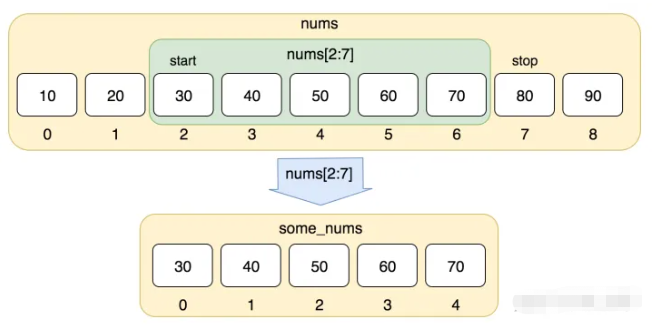
var1 = 'Hello World!'
var2 = "zhihu"
print ("var1[0]: ", var1[0])
print ("var2[1:5]: ", var2[1:5])
- 1
- 2
- 3
- 4
- 5
9、使用函数和类
函数和类是一种封装好的代码块,可以让代码更加简洁、实用、高效、强壮,是python的核心语法之一。
定义和调用函数
# Define addition function
def addition(number1, number2):
result = number1 + number2
print("Addition result:",result)
# Define area function with return statement
def area(radius):
result = 3.14 * radius * radius
return result
# Call addition function
addition(400, 300)
# Call area function
print("Area of the circle is",area(4))
- 1
- 2
- 3
- 4
- 5
- 6
- 7
- 8
- 9
- 10
- 11
- 12
- 13
- 14
定义和实例化类
# Define the class
class Employee:
name = "Mostak Mahmud"
# Define the method
def details(self):
print("Post: Marketing Officer")
print("Department: Sales")
print("Salary: $1000")
# Create the employee object
emp = Employee()
# Print the class variable
print("Name:",emp.name)
# Call the class method
emp.details()
- 1
- 2
- 3
- 4
- 5
- 6
- 7
- 8
- 9
- 10
- 11
- 12
- 13
- 14
- 15
10、错误异常处理编程过程中难免会遇到错误和异常,所以我们要及时处理它,避免对后续代码造成影响。
所有的标准异常都使用类来实现,都是基类Exception的成员,都从基类Exception继承,而且都在exceptions模块中定义。
Python自动将所有异常名称放在内建命名空间中,所以程序不必导入exceptions模块即可使用异常。一旦引发而且没有捕捉SystemExit异常,程序执行就会终止。
异常的处理过程、如何引发或抛出异常及如何构建自己的异常类都是需要深入理解的。
# Try block
try:
# Take a number
number = int(input("Enter a number: "))
if number % 2 == 0:
print("Number is even")
else:
print("Number is odd")
# Exception block
except (ValueError):
# Print error message
print("Enter a numeric value")
- 1
- 2
- 3
- 4
- 5
- 6
- 7
- 8
- 9
- 10
- 11
- 12
- 13
小结
当然Python还有很多有用的函数和方法,需要大家自己去总结,这里抛砖引玉,希望能帮助到需要的小伙伴。
作为一个IT的过来人,我分享的都是一些自己的学习方法和干货。这些Python干货可以扫码领取哦。
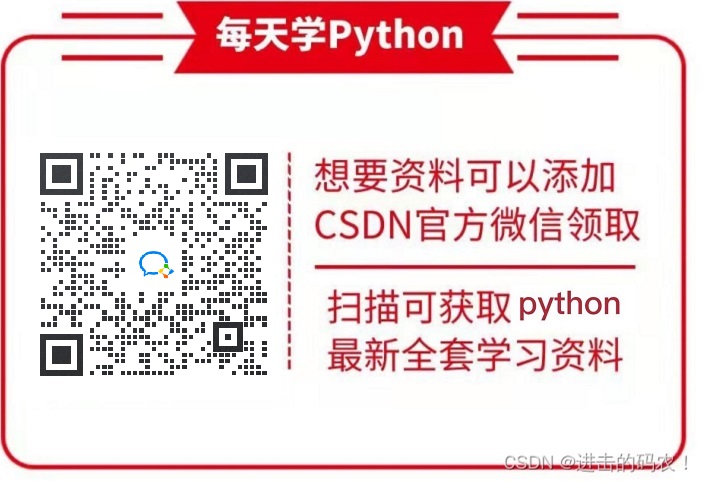
一、Python所有方向的学习路线
Python所有方向的技术点做的整理,形成各个领域的知识点汇总,它的用处就在于,你可以按照上面的知识点去找对应的学习资源,保证自己学得较为全面。
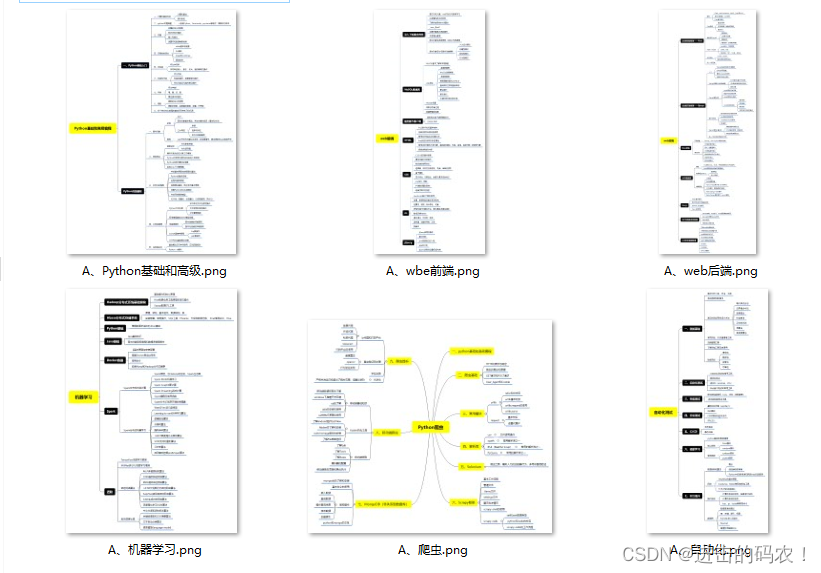
二、Python必备开发工具

三、精品Python学习书籍
当我学到一定基础,有自己的理解能力的时候,会去阅读一些前辈整理的书籍或者手写的笔记资料,这些笔记详细记载了他们对一些技术点的理解,这些理解是比较独到,可以学到不一样的思路。
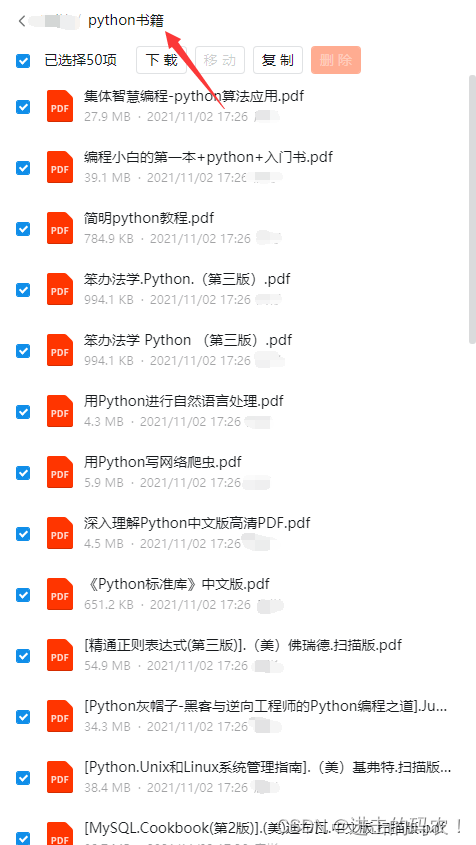
四、Python视频合集
观看零基础学习视频,看视频学习是最快捷也是最有效果的方式,跟着视频中老师的思路,从基础到深入,还是很容易入门的。
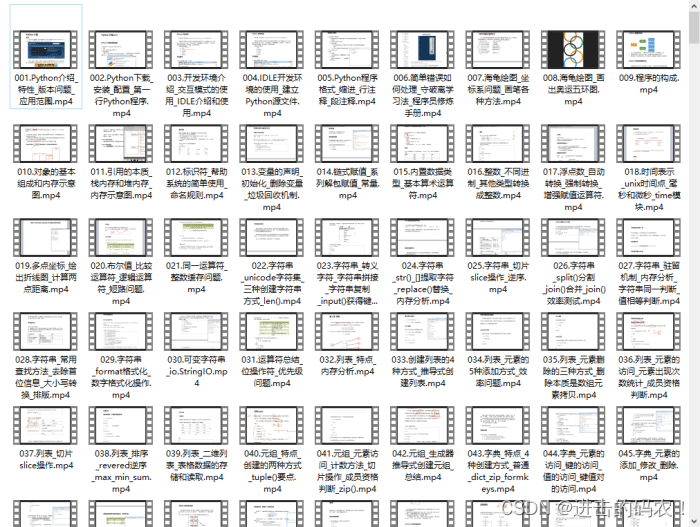
五、实战案例
光学理论是没用的,要学会跟着一起敲,要动手实操,才能将自己的所学运用到实际当中去,这时候可以搞点实战案例来学习。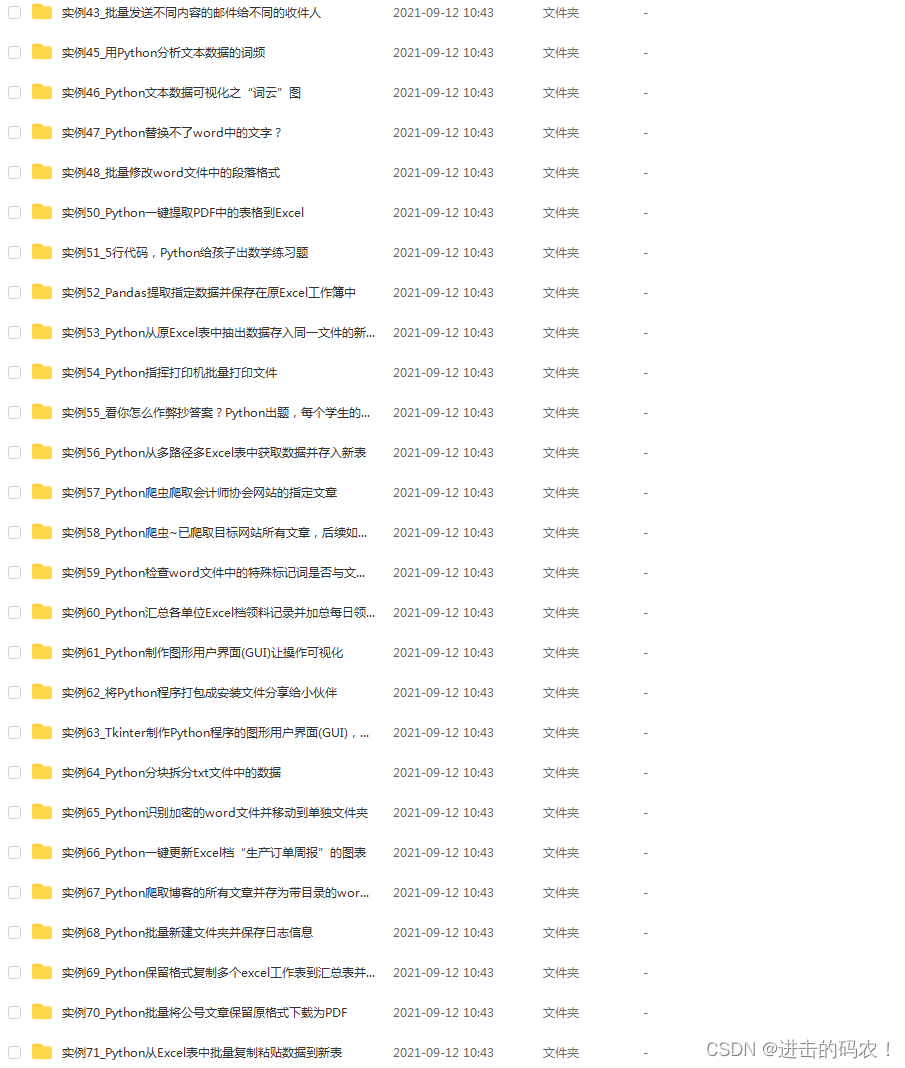
六、Python练习题
检查学习结果。
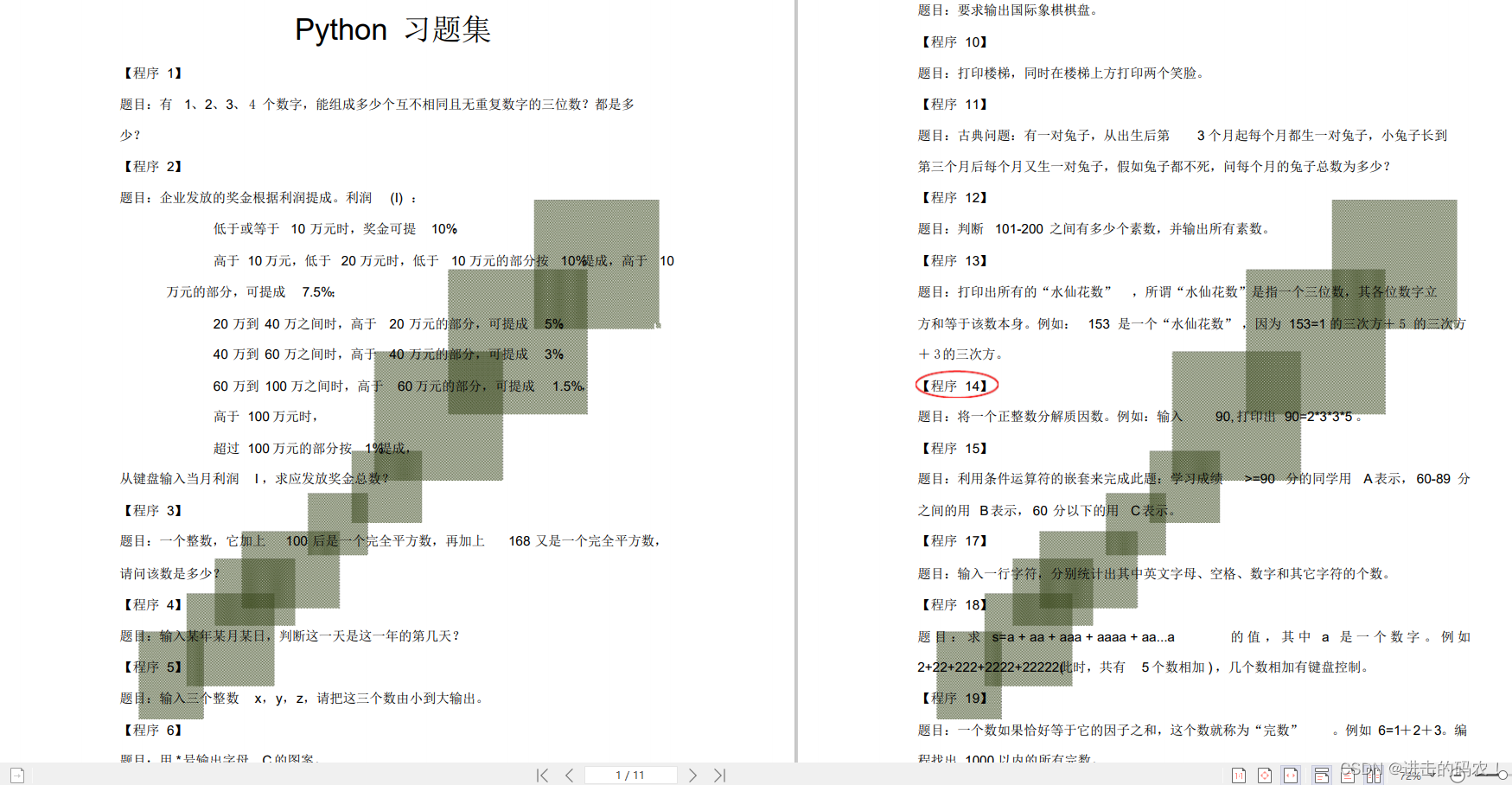
七、面试资料
我们学习Python必然是为了找到高薪的工作,下面这些面试题是来自阿里、腾讯、字节等一线互联网大厂最新的面试资料,并且有阿里大佬给出了权威的解答,刷完这一套面试资料相信大家都能找到满意的工作。
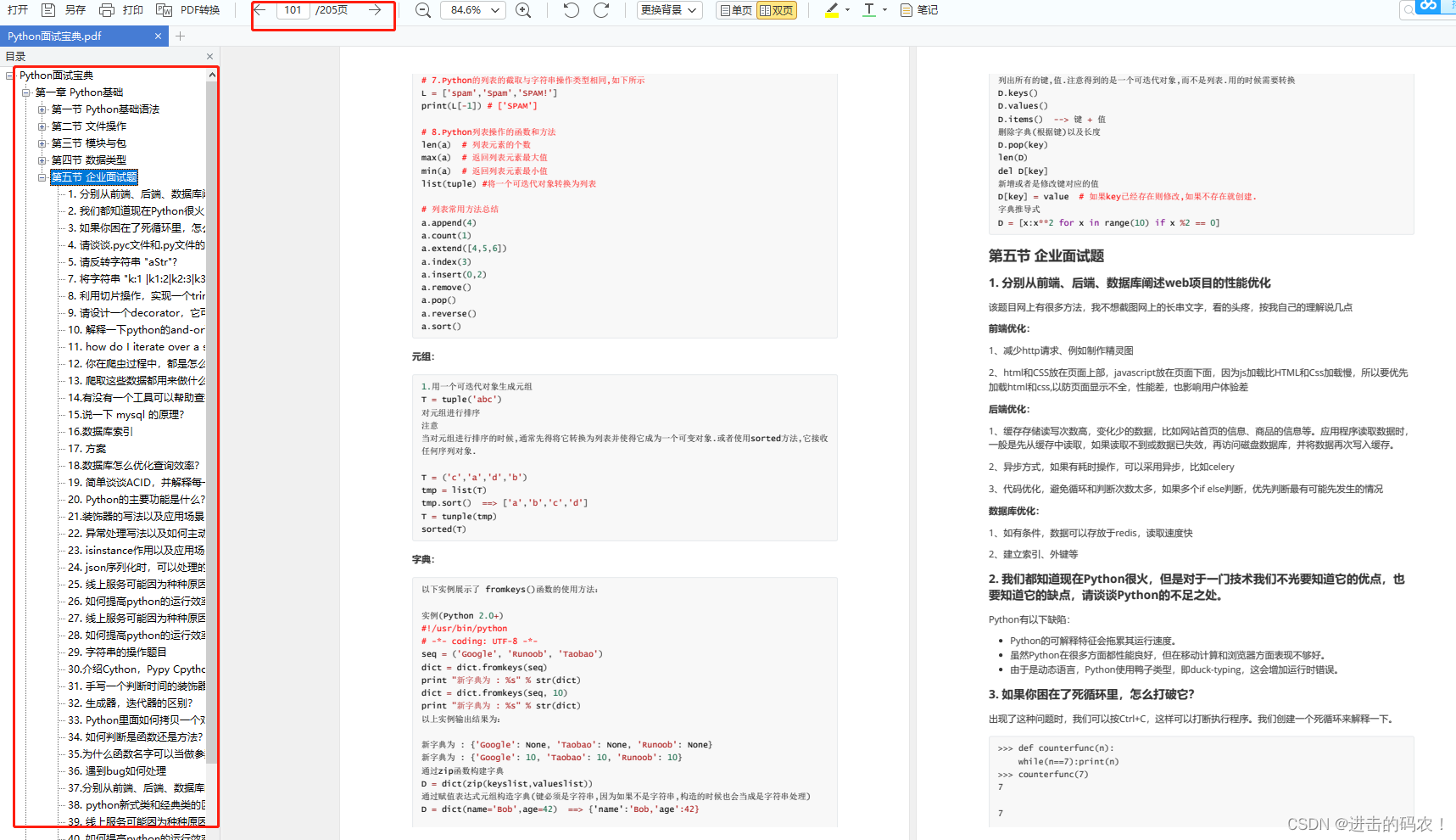
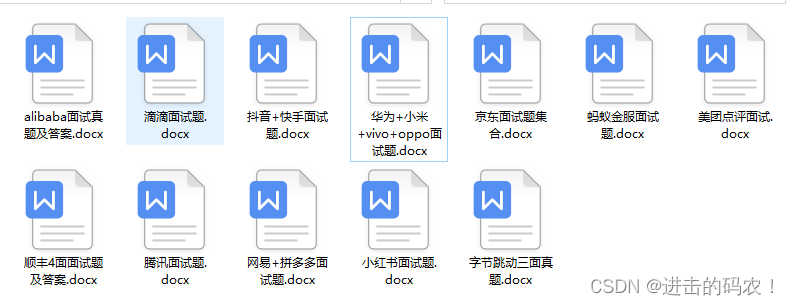
这份完整版的Python全套学习资料已经上传CSDN,朋友们如果需要可以微信扫描下方CSDN官方认证二维码免费领取【保证100%免费】





